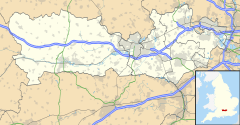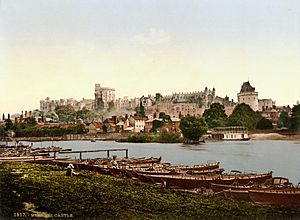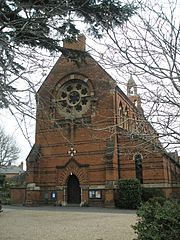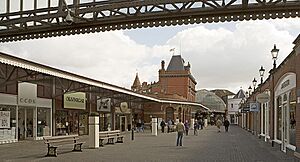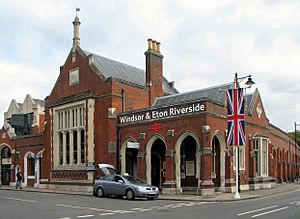Windsor, Berkshire facts for kids
Quick facts for kids Windsor |
|
|---|---|
| Town | |
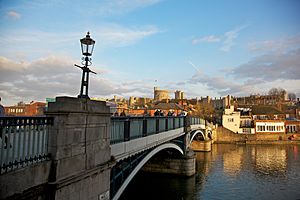 Windsor Bridge, Windsor and Windsor Castle |
|
| Population | 31,560 (Built-up area, 2021) |
| OS grid reference | SU965765 |
| Unitary authority |
|
| Ceremonial county | |
| Region | |
| Country | England |
| Sovereign state | United Kingdom |
| Post town | Windsor |
| Postcode district | SL4 |
| Dialling code | 01753 |
| Police | Thames Valley |
| Fire | Royal Berkshire |
| Ambulance | South Central |
| EU Parliament | South East England |
| UK Parliament |
|
Windsor is a famous historic town in Berkshire, England. It is best known for Windsor Castle, which is one of the official homes of the British King or Queen. The town is located about 21.8 miles (35.1 km) west of central London. It sits right next to the River Thames, which separates it from its smaller, older twin town, Eton. A village called Old Windsor is about 2 miles (3 km) south of Windsor. Old Windsor is much older, by about 300 years. In the past, people called Windsor "New Windsor" to tell it apart from Old Windsor.
Contents
- What Does the Name Windsor Mean?
- A Brief History of Windsor
- Places of Worship in Windsor
- Fun Things to Do in Windsor (Tourism)
- Shopping in Windsor
- Getting Around Windsor (Transport)
- Sports in Windsor
- Learning in Windsor (Education)
- How Windsor is Governed
- Windsor's Twin Towns
- Famous People from Windsor
- Images for kids
- See also
What Does the Name Windsor Mean?
The name Windlesora was first written down in the Anglo-Saxon Chronicle. This old name comes from Old English words. It means "winch by the riverside." A winch is a tool used to pull things, like boats, out of the water.
Around the year 1110, important meetings that used to happen at Windlesora started taking place at the Castle. This new place was called "New Windsor." This name probably showed that it was a castle and town built together. Later, by the end of the 1100s, the older settlement of Windlesora was renamed Old Windsor.
A Brief History of Windsor
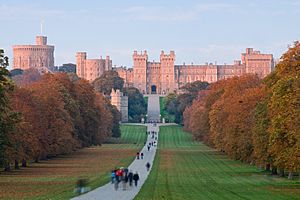
The very first history of the Windsor area is not fully known. However, people likely lived there before 1070. That's when William the Conqueror built a wooden castle there. At first, the King was more interested in a small riverside village about 3 miles (5 km) away. This village might have started around the 600s.
From the 700s, important people, possibly even royalty, began to visit the area. By the 1000s, it was known that King Edward the Confessor used the site. After William the Conqueror took over England in 1066, the kings used the area more often. This was probably because it had good woodlands for hunting. Hunting was also a way to practice military skills.
Windsor Castle is mentioned in the Domesday Book. This was a big survey of England done in 1086. The castle was listed under Clewer, a nearby area. This happened because the plans for the castle changed. More land in Clewer was bought to build a town next to the castle. This town was built in the early 1100s. King Henry I rebuilt the castle in a grander way. He even married his second wife at Windsor Castle in 1121.
How Windsor Grew in the Middle Ages
Most people from Old Windsor moved to New Windsor during the 1100s. The new town was carefully planned around 1170 by King Henry II. This plan included a parish church, a marketplace, a bridge, and a hospital. Around the same time, the upper part of the castle was rebuilt using stone.
The Windsor Bridge is the oldest bridge over the River Thames between Staines and Reading. It was first mentioned in 1191, but was likely built in 1173. This bridge was very important for travel. It connected London with Reading and Winchester. By bringing traffic into the new town, it helped Windsor's economy grow.
New Windsor was a special town from the start. It had the rights of a "free borough." This meant it had more freedoms than other towns. It had a merchant guild, which was a group for traders. In 1277, King Edward I made Windsor the main town of the county. However, this didn't last long because Windsor was hard to reach.
As a self-governing town, Windsor could run its own court. It also had some financial independence. Sadly, most of the town's old records were lost, probably in the late 1600s.
Windsor's Golden Age: The 1300s
New Windsor was a very important town in the Middle Ages. By 1332, it was one of the fifty richest towns in England. Its wealth came from being so close to the royal family. When the castle was improved, merchants from London came to the town. These included goldsmiths, wine sellers, and spice traders. This created many jobs for the townspeople.
King Edward III made huge changes to the castle between 1350 and 1368. This was the biggest building project in England during the Middle Ages. Many people from Windsor worked on this, bringing even more wealth to the town. Even though the Black Death in 1348 reduced populations in many towns, Windsor's building projects helped it grow. Its population might have even doubled! People came to Windsor from all over England and Europe. The famous poet Geoffrey Chaucer even worked at Windsor Castle in 1391.
The castle continued to grow in the late 1400s with the rebuilding of St George's Chapel. This made Windsor a major place for pilgrimage. People, especially from London, came to see the shrine of the murdered King Henry VI. They also came to see a piece of the True Cross and other important holy items.
Many pilgrims also visited the nearby college at Eton, which King Henry VI founded in 1440. Pilgrims spent a lot of money in Windsor. The number of inns in the town grew from a few to about 30 in a century. This made the town even richer. For a short time, Windsor was perhaps more important to London pilgrims than Canterbury.
Windsor in Tudor and Stuart Times
When the Protestant Reformation happened, people stopped going on pilgrimages. This caused Windsor's wealth to decline. The castle was seen as old-fashioned, and shrines were thought to be superstitious.
King Henry VIII was buried in St George's Chapel in 1547. He was buried next to Jane Seymour, the mother of his only son, Edward. Henry, who started the Church of England, might have wanted to benefit from the pilgrims visiting the town.
Most stories about Windsor in the 1500s and 1600s describe it as a poor town. Its streets were badly made, and its houses were in poor condition. Shakespeare's play The Merry Wives of Windsor is set in Windsor. It mentions many parts of the town and the countryside nearby. Shakespeare likely walked these streets, just as people do today.
During the English Civil War, Windsor was controlled by Colonel Venn. Later, it became home to the New Model Army. Even though it depended on the King, Windsor was a town that supported Parliament. King Charles I was buried in St George's Chapel after he was executed in 1649.
The current Windsor Guildhall was built between 1680 and 1691. It replaced an older market house. The town hoped for new prosperity when King Charles II returned to the Castle. However, his successors didn't use Windsor much. The town remained poor until the mid-1800s.
In 1652, the largest house in Windsor Great Park was built. It was on land that Oliver Cromwell had taken from the Crown. This house is now called Cumberland Lodge.
Windsor in Georgian and Victorian Times
In 1778, the royal family started using Windsor again. King George III lived at the Queen's Lodge and later at the castle. This led to new growth in Windsor. Two army barracks were built. In the 1700s, the town sold Windsor Chairs to London. These chairs were actually made in Buckinghamshire.
Many beautiful houses were built during this time. Hadleigh House on Sheet Street, for example, was built in 1793 by the Mayor of Windsor.
Windsor Castle was an important point for a survey done between 1784 and 1790. This survey measured the exact distance between the Royal Greenwich Observatory and the Paris Observatory. Windsor was chosen because it was close to the starting point of the survey.
The castle was greatly rebuilt in the 1800s. Queen Victoria lived there from 1840. Also, two railway lines came to Windsor in 1849. These changes brought the most dramatic improvements to the town. Windsor went from being a quiet old town to a major center of the British Empire. Many European kings and queens visited Windsor to see Queen Victoria. Sadly, much of the old town was destroyed during this rebuilding. Even the old parish church of St John the Baptist, built around 1135, was torn down in 1820.
Windsor Today
Most of the streets in Windsor today were built in the mid to late 1800s. However, the main street, Peascod Street, is very old. It existed long before the castle and might be from Saxon times. It was first called Peascroftstret around 1170. The 1000-year-old royal Castle, though the largest and longest-used in Europe, is newer in comparison. "New Windsor" was officially renamed "Windsor" in 1974.
Places of Worship in Windsor
The parish church of All Saints' is located on Frances Road. The current vicar is the Revd Ainsley Swift. The famous author Thomas Hardy trained as an architect. He worked on All Saints' church between 1862 and 1864. A special decorated screen, called a reredos, possibly designed by Hardy, was found behind some wood panels in the church in 2016.
Fun Things to Do in Windsor (Tourism)
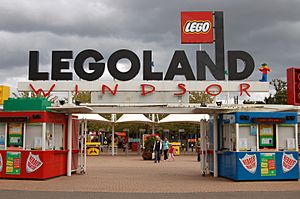
Because of Windsor Castle, Windsor is a very popular place for tourists to visit. It has many things you would find in bigger towns. These include two railway stations, a theatre, and several large hotels. You can also take boat trips on the River Thames. These trips can go to Maidenhead and Staines-upon-Thames. In winter, Alexandra Gardens has a temporary ice rink.
Near the town is Legoland Windsor Resort. This is the only Legoland park in the United Kingdom. It is also the largest Legoland park in the world by size. Legoland Windsor was built where the old Windsor Safari Park used to be.
Shopping in Windsor
Since Windsor is a tourist town, you'll find many gift shops around the castle. There are also shops and restaurants inside Windsor & Eton Central railway station. The main street for shopping is Peascod Street.
Getting Around Windsor (Transport)
Windsor has two railway stations. Windsor & Eton Central railway station is the end of the line from Slough. From Slough, you can connect to trains going to London Paddington and Reading. Windsor & Eton Riverside station has direct trains to London Waterloo. Both stations were built around the same time in the 1800s. This was because two different train companies wanted the honor of carrying Queen Victoria to Windsor.
Bus services in Windsor are provided by several companies. There are frequent buses between Windsor and Heathrow Airport, Central London, and Legoland Windsor Resort. Windsor has a large central coach park for tourist groups. You can reach it by a footbridge near Windsor & Eton Central railway station.
Windsor is connected to Eton by Windsor Bridge. This bridge is over the River Thames. It used to be for cars, but now only people walking and cycling can use it. South of Windsor are Windsor Great Park and the towns of Old Windsor, Egham, and Virginia Water. Windsor is also on National Cycle Route 4, which goes from London to Fishguard. The main roads around the town have cycle paths or nearby traffic-free routes.
Windsor has good connections to three major motorways:
- The M3 (junction 3) is about 10 miles (16 km) south. You can reach it via the A332, passing Ascot.
- The M4 (junction 6) is about 3 miles (5 km) north. You can reach it via the A332.
- The M25 (junction 13) is about 5 miles (8 km) east. You can reach it via the A308.
Sports in Windsor
Windsor's main football (soccer) team is Windsor F.C. (2011). They play in the . Their home ground used to be Stag Meadow, given to the original club by King George V in 1911. They later moved to Holloways Park.
Windsor Cricket Club has its clubhouse and pitches at Home Park. This park is next to Windsor Castle. The club hosted a special cricket match in 2006. The Windsor 1st team plays in Division 2A of the Thames Valley League.
Windsor Rugby Club also uses the Home Park ground. The team currently plays in the Southern Counties North division.
Other local sports clubs also use Home Park. These include hockey and archery clubs, and the Datchet Dashers running club.
The Royal Windsor Rollergirls were one of the first roller derby teams in the UK, started in 2007. They stopped playing in 2023.
Learning in Windsor (Education)
State Schools
Windsor has a system of three-tier schooling for state-funded schools. This means children go to different schools as they get older. There are eleven first schools for children up to 9 years old. Then, there are three middle schools for children up to age 13.
Students aged 13–18 can go to one of the town's two single-sex secondary schools: The Windsor Boys' School for boys and Windsor Girls' School for girls.
Independent Schools
Several private schools also operate in Windsor. These include:
- St George's School, Windsor Castle
Local News and Radio
Local radio stations in Windsor are community-based. These include Radio Roadhouse and Royal Borough Radio. The town's local newspaper is the Windsor Express.
How Windsor is Governed
Windsor has one level of local government. This is the Royal Borough of Windsor and Maidenhead. Its main office is in Maidenhead. The town of Windsor itself does not have its own separate local parish council. As of November 2023, the idea of creating a local council for the town was being discussed.
In 2012, the council brought back the job of town crier. The previous town crier had retired in 1892, so the job was empty for 120 years. The current town crier is Chris Brown.
Windsor's Representatives in Parliament
The current Member of Parliament (MP) for the Windsor area is Jack Rankin. He is from the Conservative Party. He was first elected in the 2024 General Election. The Windsor area includes nearby towns and villages like Eton and Datchet.
How Windsor's Local Government Changed Over Time
Windsor was an ancient borough, which is a type of old town government. It was officially called 'New Windsor'. Its first known official document, called a charter, was given in 1277. But the town was likely governed as a borough even before that. The borough covered the area of New Windsor and part of the nearby area of Clewer.
In 1836, the borough was changed to a municipal borough. This made its government more standard, like other boroughs across the country.
In 1894, a new law said that local areas could not be split across borough borders. So, the Clewer area was divided into Clewer Within (inside the borough) and Clewer Without (outside). Clewer Without was later added to the borough of New Windsor in 1920. After that, the borough had three areas: New Windsor, Clewer Within, and Clewer Without. The borough council met at Windsor Guildhall.
Windsor has been called a royal borough since medieval times. In 1926, the government said that only Windsor and Kensington were officially allowed to use this title.
The municipal borough of New Windsor was ended in 1974. It became part of the new borough of Windsor and Maidenhead. This new borough was also allowed to use the "royal borough" title. In 1998, the Royal Borough of Windsor and Maidenhead became a unitary authority. This meant it took over all local government duties.
Windsor's Twin Towns
Windsor is twinned with two other towns:
- Goslar, Lower Saxony, Germany (since 1969)
- Neuilly-sur-Seine, Hauts-de-Seine, France (since 1955)
Famous People from Windsor
Windsor has been home to many notable people:
- King Charles III and other members of the British royal family.
- Sir Sydney Camm, who designed the World War II fighter plane, the Hawker Hurricane. He lived in Windsor, and there's a model of the Hurricane near Alexandra Gardens.
- Billy Connolly, a comedian, lived in Windsor in the 1990s.
- Ranulph Fiennes, a famous adventurer and explorer, was born in Windsor.
- Dhani Harrison, musician and son of George Harrison, was born in Windsor.
- Chesney Hawkes, a musician, was born in Windsor.
- Natalie Imbruglia, an Australian pop singer, owns a house in Windsor.
- Norman Lovett, an actor known for playing Holly in Red Dwarf, was born in Windsor.
- Peter Osgood, a famous Chelsea and England footballer, was born and lived in Windsor for many years.
- Jimmy Page, a musician, lived in Windsor from 1980 to 2004.
- H. G. Wells, a famous author, lived and worked in Windsor in 1880.
Images for kids
See also
 In Spanish: Windsor (Berkshire) para niños
In Spanish: Windsor (Berkshire) para niños


